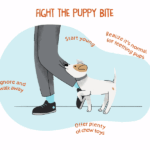
If you want to teach your puppy not to bite, you need to focus on shaping the dog’s natural play behaviour. You can start training your puppy not to bite during the first few interactions, and gradually introduce more structured play sessions as the puppy grows. The key to effective training is to use positive reinforcement. Your puppy will learn to associate negative behaviour with punishment, so avoid yelling or running away. Here are some helpful tips.
As soon as your puppy starts mouthing, show him his treat and shut your hand. When he tries to take it, say ‘no’ and reward him with another treat. Reward your puppy for his restraint with a new treat. Keep practicing until you can use your words to reinforce his new behavior. If your puppy continues to bite, introduce the cue word “leave it” to deter his mouthing.
When you are playing with your puppy, hold your hand in front of his face and if he does not bite, praise him or make a sound like “Ouch!” If you see your puppy biting something hard, stop playing with him immediately. You can also give him a reward by waving your hand in front of his face. It is important not to give him too much attention at once, as it will only set him up for failure.
When you are playing with your puppy, try to identify what triggers his bad habits. During play, your puppy may bite your fingers and hands. It is important to identify which situations trigger this behavior and redirect your puppy to a toy instead. If your puppy gets too excited, you can also try playing fetch with him instead. Playing fetch is much less dangerous than wrestling, and is a great way to train your puppy not to bite people.
If your puppy is not biting your hand, you may want to teach him not to bite people, especially strangers. As dogs are naturally protective, you need to monitor the socialization process and intervene when the play gets out of control. While you’re teaching your puppy not to bite, remember that some dogs have lower tolerances for it. Be sure to praise your pet for good behavior and encourage it whenever it happens. If you follow these tips, you’ll be on your way to preventing your pet from biting other people.
A classic bad idea is hand restraints. You’ll never teach your puppy to bite if you restrain his hands on his face. This not only suppresses his natural behaviour, but also causes him to develop a bad association between hands and teeth. The best way to avoid this problem is to teach him to avoid these situations. Once your puppy learns not to bite, he will have a much healthier relationship with you.
Using firm “no bite” commands is one way to train your puppy not to bite. You can also give a loud, high-pitched “ow” when you feel your puppy’s teeth. Be careful when disciplining your puppy. Do not scream or stare in his eyes for long periods of time because this may provoke confrontation. If possible, walk away from the scene to avoid any potential confrontation. This will help you avoid any future mishaps.








